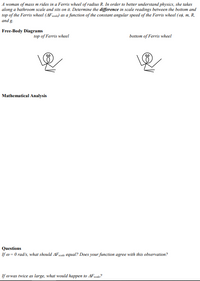Question

Transcribed Image Text:**Title:** Understanding Forces on a Ferris Wheel
**Introduction:**
A woman of mass \( m \) rides in a Ferris wheel of radius \( R \). In order to better understand physics, she takes along a bathroom scale and sits on it. Determine the difference in scale readings between the bottom and top of the Ferris wheel (\( \Delta F_{\text{scale}} \)) as a function of the constant angular speed of the Ferris wheel (\( \omega \)), \( m \), \( R \), and \( g \).
**Free-Body Diagrams:**
- **Top of Ferris Wheel:**
- A simple stick figure representing the woman sitting on a scale at the top of the Ferris wheel. The forces acting on her include gravitational force downward and normal force from the scale.
- **Bottom of Ferris Wheel:**
- Another stick figure representing the woman at the bottom of the Ferris wheel. Again, gravitational force acts downward while the normal force from the scale acts upward.
**Mathematical Analysis:**
This section is presumably left for students to calculate the difference in forces using principles of circular motion and Newton's laws.
**Questions:**
1. If \( \omega = 0 \, \text{rad/s} \), what should \( \Delta F_{\text{scale}} \) equal? Does your function agree with this observation?
2. If \( \omega \) was twice as large, what would happen to \( \Delta F_{\text{scale}} \)?
---
This exercise teaches students about the effects of centripetal force on scale readings during circular motion, exploring how velocity impacts perceived weight in different positions on the Ferris wheel.
Expert Solution
This question has been solved!
Explore an expertly crafted, step-by-step solution for a thorough understanding of key concepts.
This is a popular solution
Trending nowThis is a popular solution!
Step by stepSolved in 2 steps with 1 images

Knowledge Booster
Similar questions
- time of 5 rotations (16.5 s) Time of 1 rotation (3.3 s) Distance from shoulder to elbow (20.32cm) Distance from shoulder to middle of hand (56.99cm) A. What was the average angular speed (degrees/s and rad/s) of the hand? B. What was the average linear speed (m/s) of the hand? C. Are the answers to A and B the same or different?arrow_forwardA child is standing on a merry-go-round (u - 16) with a radius of 2 meters. What is the fastest that can he be spun while only using the friction from his feet to stay on? 157 mis 244 m/s 3.14 m/s 177 msarrow_forwardAn advertisement claims that a centrifuge takes up only 0.127 m of bench space but can produce a radial acceleration of 2600 g at 4700 rev/min. For related problem-solving tips and strategies, you may want to view a Video Tutor Solution of Throwing a discus Part A Calculate the required radius of the centrifuge Express your answer in meters. ID ΑΣΦΑ Submit Request Answer Part B Is the claim realistic? Yes O No Submit Request Answer marrow_forward
- PRINTER VERSION BACK NEXT Chapter 10, Problem 051 GO In the figure, block 1 has mass m, - 488 g, block 2 has mass m, = 551 g, and the pulley is on a frictionless horizontal axle and has radius R = 4.78 cm. When released from rest, block 2 falls 71 9 cm in 5 27 s without the cord slipping on the pulley. (a) What is the magnitude of the acceleration of the blocks? What are (b) tension T, (the tension force on the block 2) and (c) tension T, (the tension force on the block 1)? (d) What is the magnitude of the pulley's angular acceleration? (e) What is its rotational inertia? Caution: Try to avoid rounding off answers along the way to the solution. Use g = 9.81 m/s. m2 (a) Number Units (b) Number Units (c) Number Units (d) Number Units (e) Number Unitsarrow_forwardMacmillan Learning Your computer has an optical disk drive that can spin up to 10,000 rpm (which is about 1045 rad/s). If a certain disk is spun at 352.9 rad/s during the time it is being read, and then comes to rest over 0.569 seconds, what is the magnitude of the average angular acceleration of the disk? average angular acceleration: If the disk is 0.12 m in diameter, what is the magnitude of the linear acceleration of a point 1/3 of the way out from the center of the disk? linear acceleration: x10 rad/s² TOOLS m/s²arrow_forwardHow many revolutions per minute would a 26 mm -diameter Ferris wheel need to make for the passengers to feel "weightless" at the topmost point? Express your answer using two significant figures. f= _______rpmarrow_forward
- Number 4 needs answeredarrow_forwardIntro Physics I, Homework #7 See Walker Ch. 5, 6.1, 6.3, 7.1-7.2, 13.1 Submit to Google Classroom by 10 P.M., Monday, April 4 Remember to show all work and include units In Newton's late 17th century era, there were relatively accurate estimates, from terrestrial and astronomical observations and experiments, of the distance of the Earth to the Sun (dEs = 150 million 1. kilometers) and the circumference of the Earth (Cp = 40,000 kilometers [the meter was later defined during the late 18th century French revolution in relation to the size of the Earth]). Newton further estimated, likely based on the density of rocks, that the Earth was a solid sphere with a density about 6 times the density of water, which has density of pwater = 1 g/cm³.arrow_forwardV = 4 m/s ac µ = 0.1 Center of rotation R = 20 m Car around corner A 400 kg car is going around a curb as shown. The radius of the turn is 20 m and the car has a velocity of 4 m/s. The coefficient of friction between the tires and the road is 0.1 a. What is the angular velocity of the car? a. Will the car make the turn?arrow_forward
arrow_back_ios
arrow_forward_ios